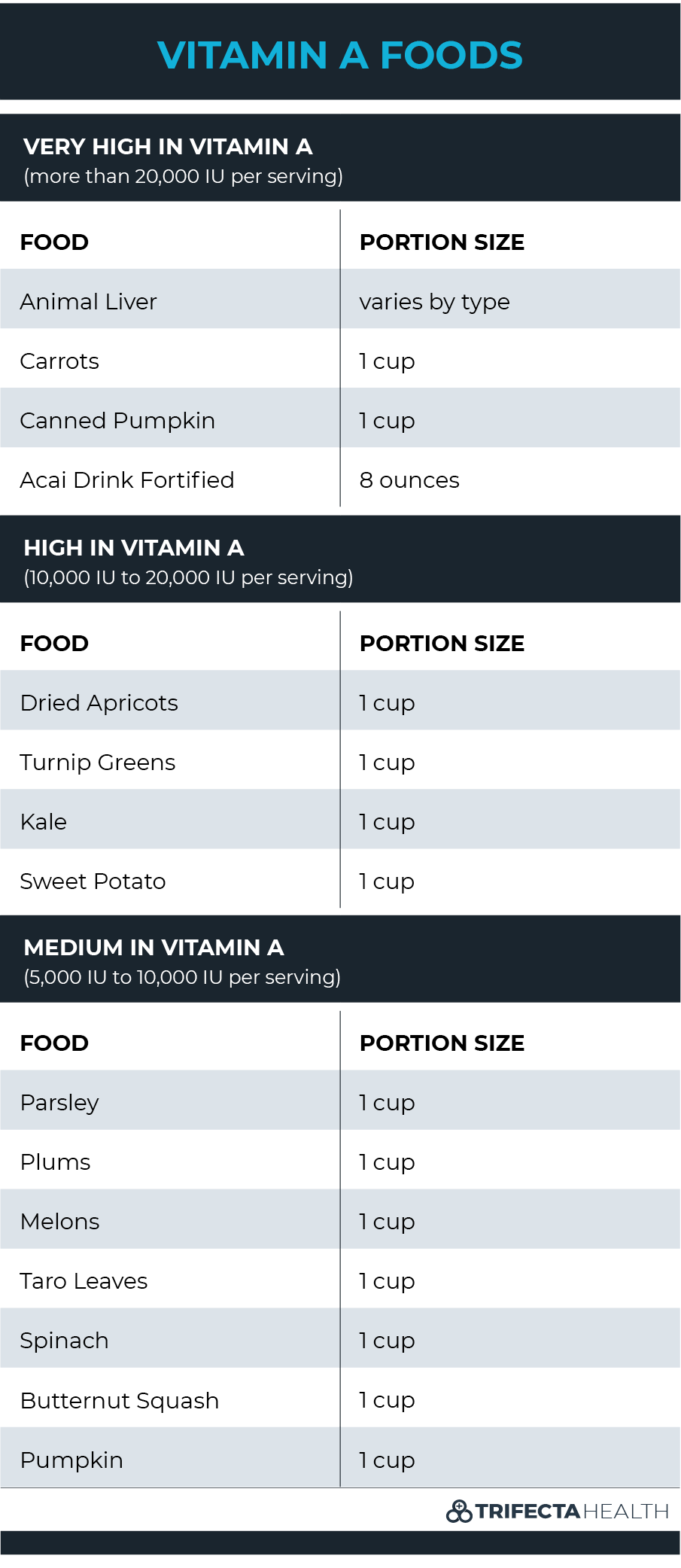Vitamin A plays an important role in supporting our bodies everyday functions including our vision, immune system and cellular health. It also helps babies as they are developing. Both too little and too much of this vitamin can lead to dangerous health consequences.
This article takes you through why vitamin A is so important, where to find it, how to get enough and why over supplementing needs to be avoided.
Vitamin A Benefits
Vitamin A includes compounds called retinoids, such as retinal, retinyl esters, and retinol.
The main functions of this micronutrient include (1):
- Vision
- Immune System Support
- Cellular Function
- Fetal Development
Vitamin A Foods
There are two types of vitamin A and you can get both from a variety of foods. Many sources of vitamin A originate from animal products including animal meat and dairy. All of these sources contain the active form - also referred to as preformed - vitamin.
Vegetables including many leafy vegetables, carrots, and some fruits have a slightly different form called provitamin A. While this is the non-active form, your body can turn it into active and effective vitamin A - and it’s just as good for you.
You can get the nutrients you need from either vitamin form. Like many important micronutrients, vitamin A is also added to many commonly eaten foods such as cereals.

Vitamin A Deficiency
About 20 million people across the world have a deficiency in vitamin A. Almost all of these deficiencies are in 3rd world countries where they isn’t easy access to the variety of nutrient rich foods in developed countries.
One of the most classic findings of vitamin A deficiency is referred to as “night blindness”, difficulty seeing in the dark, as well as other vision problems including dry eyes that is more formally named xeropthalmia (2).
Symptoms of Vitamin A Deficiency:
- Birth Defects
- Vision Changes
- Impaired Immune System (increased risk of infections)
- Stunted Growth
Deficiencies in this vitamin have also been linked to severe cases of measles.
People at Risk for Vitamin A Deficiency:
- Premature Infants
- Medical Conditions Limiting Nutrient Absorption & Storage (ie: Cystic Fibrosis; Pancreatic Insufficiency, Liver Cirrhosis)
- Living in Developing Countries
| Vitamin A Minimum Recommended Daily Intake 1 | |
| Women | 700 mcg |
| Men | 900 mcg |
Luckily, almost everyone in the United States and other developed countries has enough vitamin A just from what they eat.
Vitamin A Supplements
Supplements can come in different forms. Preformed (active) vitamin A is referred to as retinyl acetate or retinyl palmitate. Provitamin A is referred to as beta-carotene.
One of these forms are included in most multivitamins. There are also many supplements available that exclusively contain vitamin A.
People in the United States and other developed countries usually only need vitamin A supplements if they have rare medical conditions preventing their ability to absorbor store vitamin A, such as cystic fibrosis (3).
Retin-A: Vitamins for Your Skin
Topical retinoids are commonly used in beauty products. Retinoic acid is the primary ingredient in the popular skin cream ‘Retin-A’ often used to help acne and has also been shown to help sun damage. Too much of this topical cream can cause skin irritation and peeling (4).
Vitamin A Toxicity
While it seems there can always be too much of a good thing, this vitamin seems to have more side effects than many of the others when consumed in excess. Babies and people who take too many vitamin supplements are at an increased risk for experiencing these overdose symptoms.
The most severe outcome of overdose is birth defects in babies of pregnant women who regularly consume over 10,000 IU daily (5).
Symptoms of Too Much Vitamin A (6)
- Bone Problems
- High Calcium
- High Triglycerides
- Elevated Cholesterol
- Skin Changes
- Birth Defects
- Skin Changes
- Liver Problems
- Kidney Problems
- Dizziness
- Vision Changes
- Abdominal Pain
- Nausea & Vomiting
| Maximum Vitamin A Daily Intake | |
| Children | < 3,000 IU (600 mcg) |
| Adults | <10,000 IU (3,000 mcg) |
Hypervitaminosis A
Hypervitaminosis A can happen when someone takes a large amount of the performed - also known as the active form - of vitamin A.
This kind of toxicity almost always involve taking too many supplements and are usually unrelated to eating food. Rare exceptions to food causing toxicity include items like polar bear liver.
Chronic Vitamin A Toxicity
People who regularly consume too much of the vitamin - often by taking too many supplements (often greater than 25,000 IU) daily can develop chronic vitamin toxicity. Because it is a fat soluble vitamin it can be stored in the liver and other over time, and blood levels of the vitamin can build up in the body (6).
Fortunately most of the side effects (other than birth defects) go away after stopping vitamin A supplementation.
These conditions are extremely rare, and as long as your not gobbling high doses of vitamin supplements, you don’t need to worry about bad outcomes from what you’re taking.